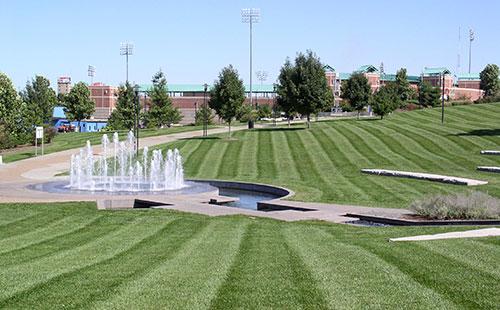OK, so what is Third Way Green?
Simply put, Third Way Green is my philosophy on landscape management (while GC Superintendents are very specialized for their task, they are certainly landscape managers). I call it 'Third Way' because there are currently two dominant landscape management approaches (an intended simplification), neither of which adequately fulfills the desired landscape potential. So there needs to be a 'Third Way' that fulfills all the benefits we are seeking from our landscapes. 'Green' comes from a focus on environmental compatibility which underpins all our landscape management.
Two Paradigms
We are presented with a cornucopia of products ranging from pesticides, to fertilizers, to every possible power tool and a host of other products for your 'landscape'... be it a golf course, college campus or athletic field. As landscape professionals, we have a huge range of products at our disposal for intervening in the landscape. This product-based management is one paradigm. Anything 'wrong' with our grounds/course can be rectified with a product.

The other paradigm is that the landscape should be left alone and nature should dictate what happens in it. All of the natural processes that affect a landscape need to be respected. These influences (environment, native flora and fauna, geology, etc.) are the truest form of intervention and the product they create is the necessary culmination of the landscape. Nothing can be 'wrong' if it is natural.
The Problem
Both of these approaches fail to take into account the diverse objectives of the modern landscape. Regardless of your position on man's influence (good or bad) on the environment, man is here to stay. To attempt to manage the commercial/recreational/educational landscape utilizing only natural processes is not useful or realistic. But to intervene in the landscape without seeking harmony with the environment is unnecessary and destructive. The Third Way seeks harmony and reconciliation between these two seemingly antagonistic needs.
Application
 Here at Drury University we are taking a Third Way approach. First we determined what the University is expecting from the landscape. We listed four objectives:
Here at Drury University we are taking a Third Way approach. First we determined what the University is expecting from the landscape. We listed four objectives:
- functionally supportive of Drury's Mission,
- aesthetically pleasing to a diverse population,
- environmentally compatible, and
- financially feasible.
Nothing earth shattering or innovative there. The Third Way approach comes in during implementation of these objectives. In most landscape projects I have been a part of, a prioritization of needs is created. Some of the needs are underserved, or forgone completely. Our approach requires all facets to be maximized.
Sustainability
 The current way we manage our landscapes is unsustainable. I don't mean this in an environmental, tree hugging, save-the-earth way, but in a way that asks "if I were to stop intervening, would this landscape perpetuate?" I may be sounding 'out there', but what I am seeking right now is not the nuts and bolts process of landscaping, but the aspiration, the destination, of my landscaping approach. Sustainability for me does not necessarily mean 'eco-friendly', but can it be sustained, and what combination of approaches achieves that?
The current way we manage our landscapes is unsustainable. I don't mean this in an environmental, tree hugging, save-the-earth way, but in a way that asks "if I were to stop intervening, would this landscape perpetuate?" I may be sounding 'out there', but what I am seeking right now is not the nuts and bolts process of landscaping, but the aspiration, the destination, of my landscaping approach. Sustainability for me does not necessarily mean 'eco-friendly', but can it be sustained, and what combination of approaches achieves that?
Conclusion
Third Way Green is a management theory that seeks to maximize, and more importantly, optimize the reconciliation of man's wants (golf) with nature's needs. It looks at the landscape from the system level rather than the component level. It is about removing frictions and diminishing inputs while increasing output and benefit. It seeks to reinforce natural systems in that everything that happens benefits the landscape and all its components. The altered landscape required by man is maintained in the most self-perpetuating way possible.
Man alters his landscape. This is not necessarily a bad thing. Nature also alters its landscape. This is not necessarily a bad thing either.



2 Comments
Recommended Comments